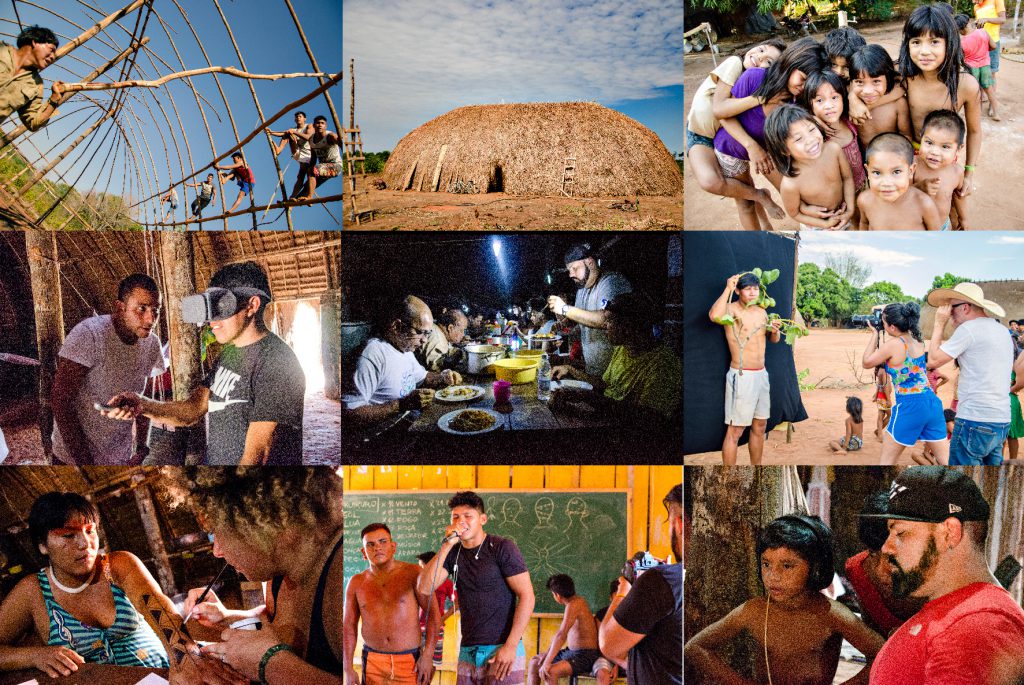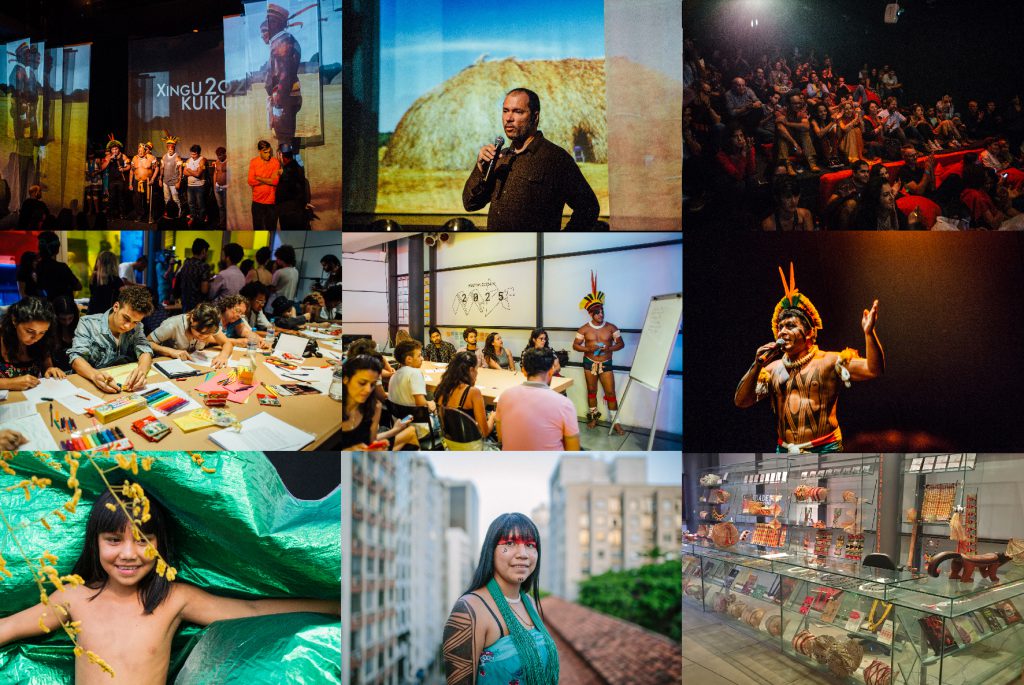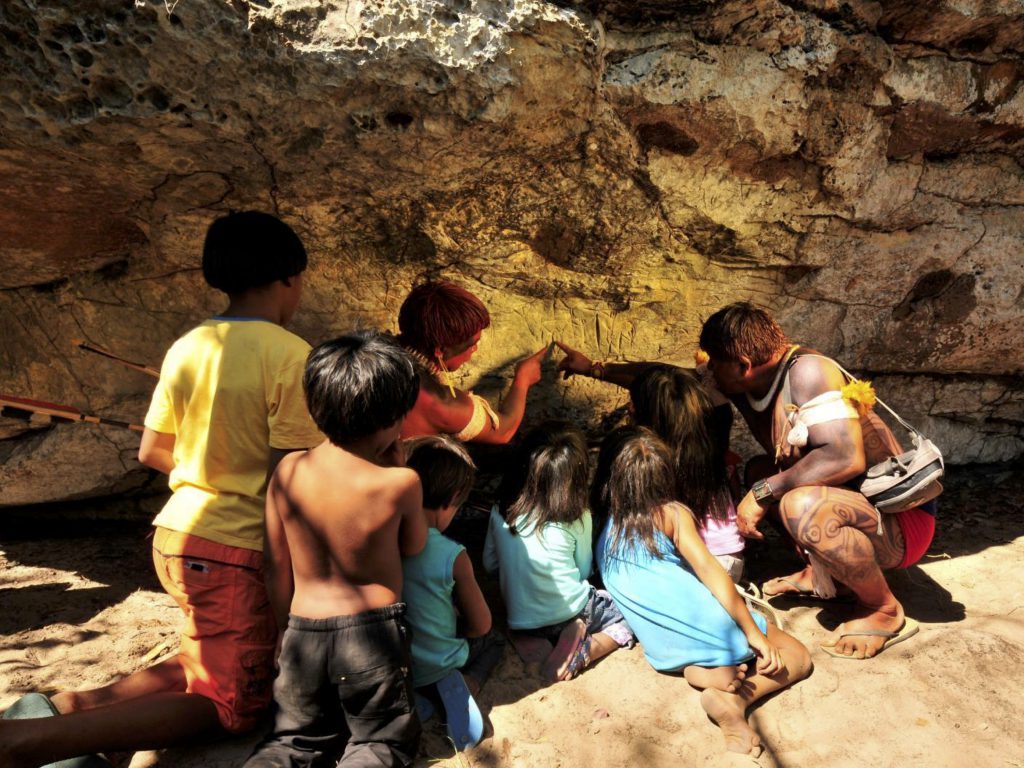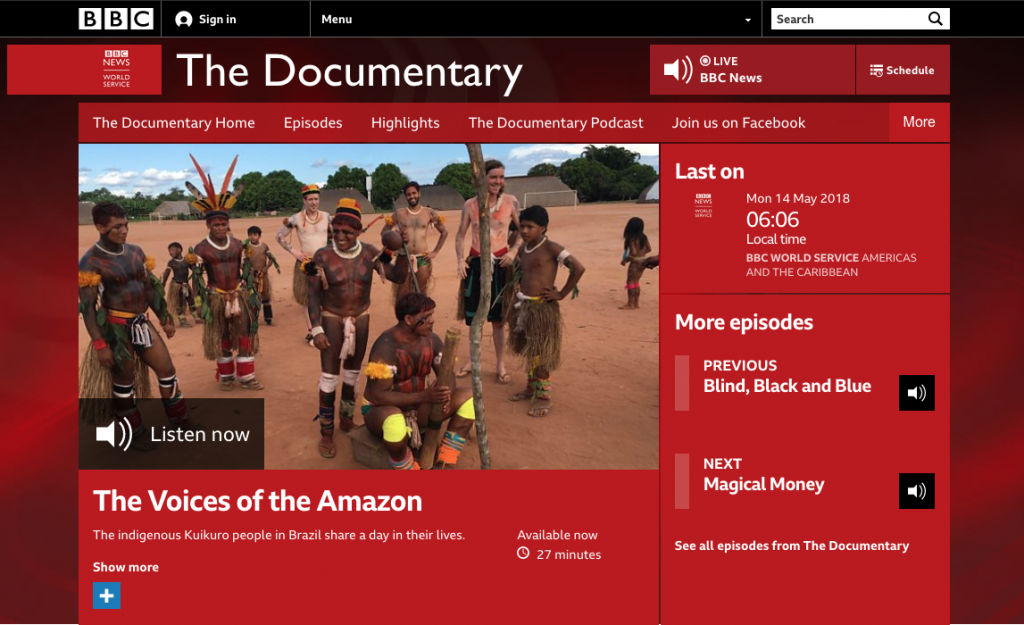To celebrate Brazil’s Dia do Índio (Indigenous Day) on April 19th, People’s Palace Projects and AIKAX (Indigenous Association of the Kuikuro People in Xingu) has launched OLOGIKO on PPP’s youtube channel. In OLOGIKO (Karib word for exchange), Takumã Kuikuro documents the exchanges between indigenous and non-indigenous artists and researchers that took place at the Ipatse village in the Upper Xingu. The film also showcases the Kuikuro residence in Rio de Janeiro in 2017, as part of Multiplicidade Festival, and the immersive installations at Tate Modern and the Horniman Museum in London in 2018. The residency programme facilitated by People’s Palace Projects between 2017 and 2018 aimed to uncover the potential for non-contact technologies to increase public understanding of the Xinguan culture, which we hope will act as an advocacy tool for the articulation of their heritage, culture and rights.
More about the partnership between People’s Palace Projects and AIKAX (2015 – present)
According to the indigenous Kuikuro people in Brazil, artists are itseke, powerful spirits of invisible knowledge. The Kuikuro are a community of around 500 people who live in the upper reaches of the Xingu River, Amazon Region. The Xingu Indigenous Park is a protected territory of more than 2.6 million hectares and home to 16 indigenous peoples, including the Kuikuro. The area was designated as a protected national park in 1961 to protect the lives and culture of its indigenous villages and to preserve the local environment.
In April 2015, filmmaker Takumã Kuikuro travelled all the way from the Ipatse village in the Xingu Indigenous Territory to London to take up a challenge from People’s Palace Projects, as part of project The Art of Cultural Exchange: to spend 6 weeks in London directing a film that would capture his vision of the city as a “village”. Takumã was selected from dozens of applicants through a grant scheme called Culture Connection Brazil, promoted by Brazil’s Ministry of Culture with the support of British Council and the Transform Programme. He was commissioned to record London from an indigenous perspective, exploring similarities and differences between his Kuikuro culture and the Londoners he christened “the Hyper-Whites”. The result is the film London as a Village, a captivating and humorous anthropological documentary about western society and the many villages hidden under the skyscrapers of London.
Ete London/London as a Village. Takumã Kuikuro, 2016.

During his residency in London, Takumã Kuikuro proposed to PPP the idea of developing an artistic residency in the Kuikuro indigenous village, aiming to forge new connections between the Kuikuro and the cultural industries, both in Brazil and abroad. Professor Paul Heritage and Takumã decided to facilitate a pilot collaborative research project that foregrounds Kuikuro cultural practices, and the villages in which they are situated, as a site for training and exchange with non-indigenous artists in order to extend understanding of how cultural interaction, creative innovation and collaborative cultural production can be conceived and measured as essential to the wellbeing of the indigenous communities and individuals.
“As artists of the Kuikuro we document our material and immaterial culture to keep our traditions alive for future generations. It is our artists who share this knowledge with society. We welcome non-indigenous artists who are interested in learning about our history and who will bring their own ways of making art to collaborate with us.” – Takumã Kuikuro
PPP and AIKAX (Indigenous Association of the Kuikuro People in Xingu) hosted the 1st artistic residency in the Xingu in May 2017, as part of the research project Social Change Through Creativity and Culture. The two-week artistic residency saw Takumã Kuikuro collaborating with British digital technology artist Adam Lowe (director of Factum Foundation) and Jerry Brotton (scholar in cartographic history at Queen Mary, University of London). The aim of the programme was to build transformative dialogues through digital technologies that enable the Kuikuro people to create 3D maps of their territories and to explore new ways in which the indigenous peoples can bring the evolving experiences of first millennial life to contemporary debates about Brazilian economic and social development in the third millennium. Adam Lowe and a group of four artists and technology experts brought to the Kuikuro village cutting-edge technologies (including aa 3D Faro laser scanner) to allow Takumã to digitally record some aspects of Kuikuro’s at-risk cultural heritage such as images, sounds, graphics, artefacts and architecture. The outcomes of the artistic exchange in May were presented to the public during the seminar Creative Lab in Xingu: Art, Technology and Cultural Preservation, hosted by Museu do Amanhã.

“Bringing a team of artists as important as Factum’s to collaborate with the indigenous Kuikuro people is a statement of the importance of indigenous artistic production in contemporary culture. This is happening in a crucial moment, where society is questioning the role of this production in social and economic development. Art is a tool for resistance and sustainability for the years to come and a challenge as we enter the third millennium.“ – Professor Paul Heritage
3D scanning of the village of Ipatse, home to almost 500 Kuikuro people. Factum Foundation, May 2o17.
A 2nd artistic residency took place in the Xingu in September 2017, as part of the research The Currency of Cultural Exchange: re-thinking models of indigenous development, undertaken in partnership with Neccult (Brazil’s leading research centre on the economy of culture). In the village of Ipatse, home to almost 500 people, the Kuikuro have constructed a traditional oca (indigenous house)as a residency centre for artists. Built with the same techniques that they have used for over 1000 years, the oca is a place for visiting artists to learn about their cultural practices and to forge new artistic collaborations. Nine artists from four cultural organisation across Rio de Janeiro (Festival Multiplicidade, Observatório de Favelas, Spectaculu and Agência de Redes para Juventude) spent 15 days with the Kuikuro indigenous people as part of the research investigating how we can measure the value of cultural exchange with Brazil’s indigenous cultures today. The residency also launched AirB2B, a new artistic exchange programme funded by the British Council. Conrad Murray, rapper and founding member of the BAC Beatbox Academy, was selected among 113 applications to join the residency in Xingu.

“Cultural exchange is about people from different communities working together to learn from each other and build mutual understanding. In a project like this, there is an extra layer of responsibility. We know that this sort of work is really effective for stimulating economic development, but we have to do that in a way that protects the culture, the land, and way-of-life that sustains the Xingu people.” – Professor Paul Heritage
Hekite Gele Ege. Conrad Murray, Sallu Kuikuro, Orlando Kuikuro, 2017. Conrad and the Kuikuro artists created this song together, composing in English, Portuguese and Kuikuro, a Karib language with about 650 speakers.
The collaborative artistic outcomes were displayed at Festival Multiplicidade, Brazil’s leading art and technology festival, in October 2017. Multiplicidade had an entire week dedicated to the cultural exchange with nine Kuikuro artists that travelled to Rio de Janeiro. The public had the opportunity to engage with various AV installations; Karib language lessons, traditional body painting, singing and dance workshops; screening of films by Takumã Kuikuro, talks with indigenous artists, activists and anthropologists, a workshop on digitisation of cultural heritage at risk; and a virtual reality experience developed during the residency in the Xingu.

https://vimeo.com/239683840
Xingu Ensemble VR experience. Clelio de Paula, WeSense, 2017.

In recognition of the collaboration with researchers from QMUL, Takumã Kuikuro was awarded a Fellowship of Queen Mary in December 2017.
The artworks of the residencies in the Xingu were presented in London for the first time in May 2018 during the event Mapping the Kuikuro Community, part of Tate Exchange week ‘Producing Memory: maps, materials, belongings’. Around 2,000 people had the opportunity to enter an inflatable oca and see photographs and listen to ambisonic sound recordings of the community’s daily life and traditions, watch a video fly-through of scan data from around the Ipatse village, and take part in the Xingu Ensemble VR experience. The programme also included an interactive photogrammetry workshop with Factum Foundation and a special screening of London as a Village, followed by a discussion on indigenous experiments in cultural exchange.


Mapping the Kuikuro Community. Producing Memory: maps, materials, belongings, Tate Exchange, 2018.
During the same month, BBC World Service made available the radio programme The Voices of the Amazon tracing a day in Takumã Kuikuro’s life in the Ipatse Village, home of the Kuikuro people in the Xingu region, as well as the clip The Jungle Village Hooked on Their Phones. The recordings were facilitated by PPP during the first residency in the Xingu in May 2017.
The Documentary, The Voices of the Amazon. BBC World Service, 2018.
In 2018 PPP extended its relationship with AIKAX and associate artist Takumã Kuikuro in an exciting new digital project in partnership with Factum Foundation, The Horniman Museum and Gardens, A Casa Gringo Cardia, Playground Entertainment and WeSense. A third residency took place in Xingu in September 2018, as part of the project The Challenge of the Xingu: indigenous cultures in the museum of the future., aimed to combine the digital data capture associated with world-leading cultural conservation practice (such as photogrammetry and 3D scanning/printing) with motion-capture, VR/AR tools such as Oculus Rift headsets, and traditional Kuikuro objects and artefacts to prototype an immersive experience for UK museum audiences of the day to day life, environment, myths and storytelling, dance, graphism, decorative painting, crafts and other cultural practices of the Kuikuro village.

Third residency, September 2018.
The immersive installation Xingu Village was piloted for two days at the Horniman Museum in December 2018. By combining digital content, augmented reality tools, ambisonic recordings and never-seen archive footage by Takumã Kuikuro, over 200 people had the opportunity to embark on a museum journey to the Ipatse village. The installation, the first of its kind, involved indigenous people directly in a process that both preserved and disseminated their social and cultural histories. Through the use of non-contact technologies, the project has raised awareness of remote and fragile indigenous communities, whose way of life is beyond the reach of the general public, without putting them at risk. Click here to read full evaluation written by Chrissie Tiller.
“From the Xingu we learn how arts and cultural practices are essential to the preservation of life and the protection of the global environment. This unique international partnership shows how immersive technologies create new connections between objects and people, revealing the stories we need to tell and to hear about the world around us.” – Paul Heritage


Xingu Village, 2018. Jornal da Cultura, 04/01/2019 (In Portuguese)
In March 2019, on behalf of the ESRC and AHRC, PPP and AIKAX hosted a three-day seminar on Indigenous Research Methods in Rio de Janeiro, in partnership with Museu do Índio and Planetário do Rio. The seminar brought together researchers from a wide variety of indigenous communities in 10 different countries (Brazil, Colombia, India, Mongolia, Kenya, Uganda, Sudan, Kiribati, Papua New Guinea and Dominica) as well as Principal Investigators from 11 UK universities and 1 public research institution. Each multi-national team has written a Case Study based on their own experiences of collaborative research, and the group’s discussions were focused on culturally sensitive knowledge exchange, co-creation and mobilisation for meaningful impact. Research collaborations with indigenous people have become an increasingly important topic within the Research Councils’ Global Challenges Research Fund portfolio. The intention of this workshop was to critically reflect on and document processes that enable non-indigenous researchers and indigenous communities to engage together to conduct equitable, context-specific, historically, culturally and linguistically sensitive research, knowledge co-creation and mobilisation.
UKRI intends to develop a publication following the workshop that indicates important issues to consider and guidelines for best practice for undertaking international development research with indigenous people. This will be a resource for UK and International researchers when planning future research and responding to opportunities for collaboration, as well as guiding UKRI’s future strategic research initiatives.

Indigenous Research Methods Seminar, Museu do Indio, Rio de Janeiro. March 2019.
Next Steps: The Sacred Cave of Kamukuwaka
During the research trip in September 2018 to capture digital data for the development of Xingu Village installation, part of the research project The Challenge of the Xingu, it was discovered by members of the Wauja community, specialists from Factum Foundation and an independent team of Brazilian anthropologists that the ancient carvings in the sacred cave site of Kamukuwaka, listed as a heritage site in 2010 by IPHAN (Brazil’s National Institute of Historic and Artistic Heritage), had been deliberately destroyed through systematic vandalism. Although no perpetrator has yet been identified, the destruction is likely to be a result of the ongoing tensions between indigenous and farming communities in the state of Mato Grosso.
Upon arrival at the site, it was revealed to have been devastated with the most important petroglyphs hacked away. In spite of this, Factum Foundation’s team recorded the site in its vandalised condition. This data is being used in combination with photographic documentation dating from before the attack to produce an accurate 3D restoration of the cave (9x5x4 m) that will be displayed in Madrid in October 2019, before being shipped to the Wauja community in the Xingu.
The reconstructed physical cave will be exhibited with material that explores the cultural significance of the site as well as the technological challenge of restoring it. It is hoped that this artistic and technological statement will have a real-world impact, by gathering support for the Wauja with what they believe to be the only way to safeguard Kamukuwaka: to reclaim it and its surroundings as indigenous lands and reinstate a village nearby.
The sacred cave of Kamukuwaka provides a vital insight into ancient Xinguan cosmogonic and ethno-historic cartography. As the legendary site of the residency and reclusion of the mythical hero-ancestor Kamukuwaka and his people, it is a space that is associated with the origin of the ear piercing initiation ritual of Xinguan communities’ young leaders. Its engravings represent the source of much of the Xinguan traditional graphic repertoire, being widely reproduced in ritual body paintings, traditional pottery, and basketry.
The sacred Kamukuwaka site is excluded from the Xingu’s demarcated territory, and therefore more vulnerable to direct non-indigenous contact despite its status as an official heritage site – as well as to the environmental effects of deforestation, rising water levels and rock erosion. Kamukuwaka is a site that resonates deeply with the traditions of the inhabitants of Xingu, as well as demonstrating the grave contemporary threats to their way of life.

Kamukuwaka site vandalised, 2018.
Media archive (in Portuguese):
- BBC: Ato de vandalismo destrói gravuras históricas sobremito indígena em caverna do Xingu
- Estadão: Gravuras rupestres sagradas para tribos do Xingu são destruídas
- O GLOBO: Gravuras rupestres são apagadas de caverna sagrada para os índios no Mato Grosso
- Folha de S. Paulo
- G1 Mato Grosso
- UOL Noticias
- IstoE
- Jornal Estado de Minas
- Metrópoles
- Portal Terra
- Manchetes Socioambientais
- Olhar Indígenas
- Folha MT
- A Tarde – UOL
- Instituto Socioambiental
https://vimeo.com/322057041


